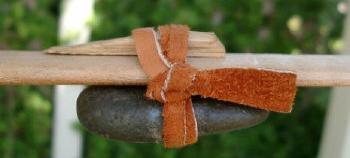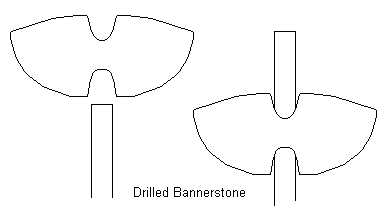|
Daryl Hrdlicka Jeffers Petroglyphs Historic Site February 18, 2003 Atlatl weights are small pieces of rock, antler, or bone which are added to the shaft of an atlatl in order to increase the weight of a certain area. These weights (also known as bannerstones, birdstones, and boatstones) are a purely North American invention. They have not been found anywhere else in the world. They are most effective on thin-shafted flexible atlatls, but sometimes are used on rigid atlatls as well. Theories about their use abound, but I'm not going to get into that here. This article is simply to help you attach the weights to your atlatl. Atlatl weights come in three basic shapes and forms. The first, and simplest, is the round weight. These are usually just river rocks of the desired weight and size which are tied onto the atlatl shaft. I realize that most of the people reading this (including myself) don't live near a convenient river, but there's an easy way to get them. Just go to a local store with decorative rocks around the building (I prefer Shopko). Good rocks are usually about 2" long, 1" wide, and 1/2" thick, and fairly flat on one side. They can be tied on to the atlatl in one of two ways. The first way is by using a single wrapping of sinew around the middle of the stone, binding it to the shaft. When you are done wrapping, take some more sinew and wrap it around the binding between the stone and the shaft. This will raise the stone slightly, but it will also increase the tension of the binding and therefore the grip. You don't need to do this second wrap, but it helps secure the stone. You may want to coat it with glue afterwards so the sinew doesn't slip.  If the round stone is larger, or you just want a more secure grip, you can use a double binding. Wrap sinew around both ends of the stone instead of the middle, then wrap sinew around the bindings between the rock and the shaft again, pulling it tight. This gives a four-point grip which is less prone to slipping or shifting.  There's also a third way I've recently discovered, which basically combines the other two styles. Wrap the rock on both ends, but bring it to a common point on the atlatl shaft forming a "V" shape. Again, you can wrap it with sinew afterwards for a more secure grip.  I found an interesting idea on the Atlatl chat board, posted by Ray Madden (I think). If you want to experiment with atlatl weights but don't know where to put them for maximum effectiveness, use a leather thong to tie them onto the shaft, then insert a wooden shim to hold it in place. If it doesn't work properly, you can move it and try it again. When you find the right position for it, just remove the thong and shim and bind it on permanently.  The second style of atlatl weight is the elongated weight. These are usually soapstone but may also be made of antler or bone. It is an elongated shaped weight, flattened on one side to fit snugly against the back of the atlatl. Shorter ones are grooved across the middle; longer ones are grooved on both ends. The longer style is usually used on more rigid designs, since the stone is obviously not going to flex. To use this style, simply carve out your weight to the desired length and weight. Lay it on the shaft in the appropriate place (you may want to carve grooves or notches in the shaft corresponding to the ones in the weight) and bind it down with sinew. You can apply glue or pitch to help bind the stone to the shaft, and you may want to coat the sinew with glue as well.  The third style of atlatl weight, the drilled bannerstone, is the one known to most people, but it is beyond the capabilities of most beginners (it's beyond me, anyway). These are weights with a hole drilled through the vertical axis, designed to be slipped over the end of the atlatl. The atlatl style these can be used on are obviously limited, and there is some doubt as to whether they actually were weights, but when found in archaeological sites they are nearly always located near other atlatl parts like the peg and handle. These are usually intricately carved and shaped. If you do find a modern replica you'd like to mount, you have to make the shaft of the atlatl thin and round so the bannerstone can slip over it. When it's in the place you'd like, wrap above and below it with sinew so it can't slide around the shaft.  I hope this information is useful to you in making your own atlatl weights. |